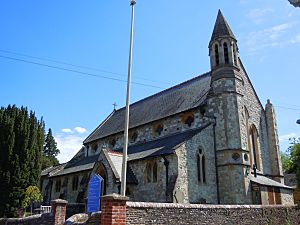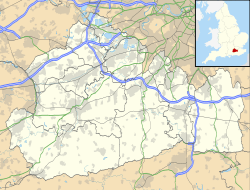St Peter's Church, Wrecclesham facts for kids
Quick facts for kids St Peter's Church, Wrecclesham |
|
|---|---|

View of church from School Hill
|
|
| 51°11′53″N 0°49′04″W / 51.1980°N 0.8178°W | |
| OS grid reference | SU 82698 44977 |
| Location | Wrecclesham, Surrey |
| Country | England |
| Denomination | Anglican |
| Website | CofEWrecclesham.org.uk |
| History | |
| Status | Active |
| Founder(s) | Bishop Charles Sumner |
| Dedication | Saint Peter |
| Consecrated | 16 July 1840 |
| Architecture | |
| Functional status | Parish church |
| Heritage designation | Grade II |
| Designated | 29 December 1972 |
| Architect(s) | James Harding |
| Administration | |
| Deanery | Farnham |
| Archdeaconry | Surrey |
| Diocese | Guildford |
| Province | Canterbury |
St Peter's Church is a busy Anglican church located in Wrecclesham, a village near Farnham in Surrey, England. It's a special kind of church called a Parish church, which means it serves the local community. The church was officially opened in 1840. Today, it is a Grade II listed building, which means it's an important historical building protected by law.
Contents
The Story of St Peter's Church
Why the Church Was Built
Back in 1820, the village of Wrecclesham had some challenges. A person visiting from Australia, who lived in Farnham, noticed that the village needed more positive activities. They felt it was important to create better places for people to spend their time.
The Bishop of Winchester, who lived nearby at Farnham Castle, heard about the situation in Wrecclesham. He decided that building a church would help bring good things to the village.
People started collecting money to build the church. After raising £1000, construction began. The new church was officially opened on July 16, 1840, by Bishop Charles Sumner.
Growing the Church Building
When it was first built, St Peter's was a small church. It had a main area called a chancel, a nave, and a north transept (a part that sticks out). The first vicar, Rev. R. D. Buttermer, was so important that a street in Wrecclesham, Buttermer Close, is named after him.
Over the years, the church became bigger. In 1861, the chancel was rebuilt, and a south aisle (a side section) was added. Later, in 1876, the nave was rebuilt, and a north aisle was added.
In 1890, Rev. Charles Keable became the vicar. He served the church for 33 years. After he passed away in 1923, Keable Road in Wrecclesham was named in his honor.
The church's organ has an interesting history too. It originally came from St James' Church in Farnham. In 1975, when St James' was turned into apartments, the organ moved to St Peter's. A new organ was bought in 1996 and installed in June 2001.
Helping the Community Grow
Building the church was just the beginning of helping the village. Many other important buildings and projects started from the church's efforts.
- In 1860, St. Peter's School opened.
- The Wrecclesham choir was formed from the school.
- The Wrecclesham Institute was built soon after. It's across from the church on School Hill. This institute offered many sports and social groups for local people. It was even a founding team of the Wrecclesham Cricket Club.
- The Knights Almshouse, a special home for older people, was built down the hill from the church.
The parish hall, which is right next to the church, is called Leverton Hall. It was named after Rev. Charles Leverton, who passed away in 1973. This hall was added in the early 1970s after the old village hall was taken down.
Images for kids
See also
- Wrecclesham






